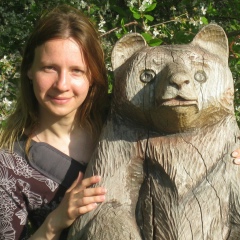Многие традиции, на которых строился образ жизни русского человека, стерлись из нашей исторической памяти или свернулись до простейших и безынтересных действий. Попытаемся восстановить в уме главные из них.
1«Деток родить – не веток ломить»
Родильные дома в России появились только в 18-м веке, но они предназначались для бедняков или тех, кто собирается своих детей отдать. До революции детей старались рожать дома, а ещё лучше – в бане, в тепле, подальше от чужих глаз. Следуя приметам, чтобы облегчить роды, роженице расплетали косы, с неё снимали украшения, распоясывали. Все сундуки, шкафы, окна и двери следовало открыть. Помогали роженицам повитухи. Причём помогали не только во время родов, но и после них: первые несколько дней они занимались хозяйством в доме. 8-го января отмечался праздник «бабьи каши», в который принято было благодарить повитух, преподносить им подарки.
2 Именины, а не день рожденья
Именно именинами, то есть днём ангела, а не днём рожденья отмечался каждый новый год в жизни человека. При советской власти этот пережиток царского режима был постепенно искоренён. Другим стал сам характер праздника: теперь акцент ставился на физическом, а не духовном рождении. До 17-го века утро именинника начиналось с молитвы и причастия. Затем в качестве приглашения на именины родственникам и друзьям приносили испечённые накануне пироги. Тот, кто принёс пирог, говорил: «Именинник приказал кланяться пирогами и просил хлеба кушать». Пирог был главным блюдом праздника. Его разламывали над головой именинника, чтоб на того, как крошки, «сыпалось золото и серебро».
3 Дом построить
Строительство дома было делом не просто сложным и ответственным, но жизненно важным. Начиналось строительство со знакомства с местом, на котором хозяин собрался возводить дом. Для того, чтобы определить, каков гений места, существовало множество примет. К примеру, вечером на землю клали сухую овечью шкуру, а утром её выжимали. Если шкура оставалась сухой, значит, строительство принесёт хозяину разорение. Или с каравая отрезали ломоть, посыпали его солью и клали туда же. Если за ночь хлеб успевал пропасть, его отдавали собаке и начинали строить. Под основание строящегося дома клали несколько монет и дом освящали. Иногда под основание закапывали голову петуха.
4Переезд с домовым
При переезде в новый дом следовало не забыть о домовом, который верой и правдой жил у вас много лет. Для того чтобы домовой не остался на старом месте, хозяева забирали с собой веник. Также перед переездом складывали в небольшую коробку старые не острые вещи и выставляли её на 10 минут за порог. Тогда домовой переезжал вместе с хозяевами на новое место.
5 Кулачные бои
Кулачный бой был не просто дракой ради забавы или удали – он был одним из способов воспитания воинов. Изначально в нём не существовало правил: он назывался сцепным боем, и в нём каждый был сам за себя, каждый дрался со всеми. Позже кулачный бой превратился в боевое искусство со своими правилами и тактическими приёмами. Здесь нельзя было использовать оружие, бить лежачего и драться можно было только кулаками. Существовали три возрастные группы: мальчики, неженатые юноши и взрослые мужчины. Бой вёлся стенкой на стенку, то есть командами, и у каждой команды был вожак. Церковь осуждала кулачные бои, и их время от времени запрещали, начиная с 17-го века. После революции запретили вовсе.
6 Воспитание воинов
Разумеется, кулачные бои были не единственным инструментом воспитания воинов. Сызмала мальчики играли в царя горы, кучу-малу, ледяные горки. В качестве игрушек были у них и деревянные мечи. А малолетние князья чуть ли не с трёх лет носили на поясе боевое оружие. Обряд посвящения мальчика в воины свершался, когда ему исполнялось два или три года: мальчика постригали и сажали на коня. Чем старше он становился, тем чаще его брали на битву или охоту. Уже в подростковом возрасте князья нередко брались за мечи.
...
http://russian7.ru/2012/11/7-zabytyx-tradicij/
1«Деток родить – не веток ломить»
Родильные дома в России появились только в 18-м веке, но они предназначались для бедняков или тех, кто собирается своих детей отдать. До революции детей старались рожать дома, а ещё лучше – в бане, в тепле, подальше от чужих глаз. Следуя приметам, чтобы облегчить роды, роженице расплетали косы, с неё снимали украшения, распоясывали. Все сундуки, шкафы, окна и двери следовало открыть. Помогали роженицам повитухи. Причём помогали не только во время родов, но и после них: первые несколько дней они занимались хозяйством в доме. 8-го января отмечался праздник «бабьи каши», в который принято было благодарить повитух, преподносить им подарки.
2 Именины, а не день рожденья
Именно именинами, то есть днём ангела, а не днём рожденья отмечался каждый новый год в жизни человека. При советской власти этот пережиток царского режима был постепенно искоренён. Другим стал сам характер праздника: теперь акцент ставился на физическом, а не духовном рождении. До 17-го века утро именинника начиналось с молитвы и причастия. Затем в качестве приглашения на именины родственникам и друзьям приносили испечённые накануне пироги. Тот, кто принёс пирог, говорил: «Именинник приказал кланяться пирогами и просил хлеба кушать». Пирог был главным блюдом праздника. Его разламывали над головой именинника, чтоб на того, как крошки, «сыпалось золото и серебро».
3 Дом построить
Строительство дома было делом не просто сложным и ответственным, но жизненно важным. Начиналось строительство со знакомства с местом, на котором хозяин собрался возводить дом. Для того, чтобы определить, каков гений места, существовало множество примет. К примеру, вечером на землю клали сухую овечью шкуру, а утром её выжимали. Если шкура оставалась сухой, значит, строительство принесёт хозяину разорение. Или с каравая отрезали ломоть, посыпали его солью и клали туда же. Если за ночь хлеб успевал пропасть, его отдавали собаке и начинали строить. Под основание строящегося дома клали несколько монет и дом освящали. Иногда под основание закапывали голову петуха.
4Переезд с домовым
При переезде в новый дом следовало не забыть о домовом, который верой и правдой жил у вас много лет. Для того чтобы домовой не остался на старом месте, хозяева забирали с собой веник. Также перед переездом складывали в небольшую коробку старые не острые вещи и выставляли её на 10 минут за порог. Тогда домовой переезжал вместе с хозяевами на новое место.
5 Кулачные бои
Кулачный бой был не просто дракой ради забавы или удали – он был одним из способов воспитания воинов. Изначально в нём не существовало правил: он назывался сцепным боем, и в нём каждый был сам за себя, каждый дрался со всеми. Позже кулачный бой превратился в боевое искусство со своими правилами и тактическими приёмами. Здесь нельзя было использовать оружие, бить лежачего и драться можно было только кулаками. Существовали три возрастные группы: мальчики, неженатые юноши и взрослые мужчины. Бой вёлся стенкой на стенку, то есть командами, и у каждой команды был вожак. Церковь осуждала кулачные бои, и их время от времени запрещали, начиная с 17-го века. После революции запретили вовсе.
6 Воспитание воинов
Разумеется, кулачные бои были не единственным инструментом воспитания воинов. Сызмала мальчики играли в царя горы, кучу-малу, ледяные горки. В качестве игрушек были у них и деревянные мечи. А малолетние князья чуть ли не с трёх лет носили на поясе боевое оружие. Обряд посвящения мальчика в воины свершался, когда ему исполнялось два или три года: мальчика постригали и сажали на коня. Чем старше он становился, тем чаще его брали на битву или охоту. Уже в подростковом возрасте князья нередко брались за мечи.
...
http://russian7.ru/2012/11/7-zabytyx-tradicij/
Many of the traditions on which the way of life of a Russian person was built have been erased from our historical memory or curtailed to the simplest and uninteresting actions. We will try to restore the main ones in our minds.
1 "To give birth to children - not to break branches"
Maternity homes in Russia appeared only in the 18th century, but they were intended for the poor or those who are going to give their children. Before the revolution, children tried to give birth at home, and even better - in the bath, in the warmth, away from prying eyes. Following the signs, to facilitate childbirth, the woman in labor untied the braids, she was removed from her jewelry, unleashed. All chests, cabinets, windows and doors had to be opened. The midwives helped the mothers. And they helped not only during childbirth, but also after them: for the first few days they were engaged in housekeeping. On the 8th of January, the feast “woman’s porridge” was celebrated, on which it was customary to thank the midwife and present them gifts.
2 Name day, not birthday
It was the name day, that is, the day of the angel, and not the day of birth, each new year was celebrated in a person’s life. Under the Soviet regime, this relic of the tsarist regime was gradually eradicated. Another was the nature of the holiday: now the emphasis was on physical, not spiritual birth. Until the 17th century, the birthday of the birthday party began with prayer and communion. Then, as an invitation to the name day, cakes baked on the eve were brought to relatives and friends. The one who brought the cake said: "The birthday man ordered to bow down with pies and asked for bread to be eaten." The cake was the main dish of the holiday. It was broken over the birthday man's head, so that, like crumbs, "gold and silver were falling."
3 House to build
Building a house was not only difficult and responsible, but vital. Construction began with an acquaintance with the place where the owner was going to build a house. In order to determine what the genius of the place, there were many will take. For example, in the evening they put dry sheep skin on the ground, and in the morning they squeezed it. If the skin remained dry, it means that the construction will bring ruin to the owner. Or with a loaf cut off a chunk, sprinkled with salt and put it there. If during the night the bread had time to disappear, it was given to the dog and began to build. Under the base of the house under construction were put a few coins and the house was consecrated. Sometimes a rooster’s head was buried under the base.
4Moving with the house
When moving to a new house should not forget about the brownie, who faithfully lived with you for many years. In order that the brownie did not stay in the old place, the owners took a broom with them. Also, before moving, they put old, not sharp things into a small box and put it out for 10 minutes on the threshold. Then the house moved with the owners to a new place.
5 Fist fights
Fist fight was not just a fight for fun or daring - he was one of the ways to educate soldiers. Initially, there were no rules in it: it was called a coupling fight, and in it everyone was for himself, everyone fought with everyone. Later, fistfight turned into a martial art with its own rules and tactical techniques. It was impossible to use weapons here, to beat the recumbent and to fight it was possible only with fists. There were three age groups: boys, unmarried boys, and adult men. The fight was led wall to wall, that is, the teams, and each team had a leader. The church condemned the fist fights, and from time to time they were forbidden since the 17th century. After the revolution banned altogether.
6 Warrior Education
Of course, the fist fights were not the only tool for educating warriors. Sickle boys played king of the mountain, a bunch of little, ice slides. They also had wooden swords as toys. And for almost three years young princes wore combat weapons on their belts. The rite of initiation of the boy into warriors was accomplished when he was two or three years old: the boy was tonsured and put on a horse. The older he got, the more often he was taken to a battle or a hunt. Already in adolescence princes often took up swords.
...
http://russian7.ru/2012/11/7-zabytyx-tradicij/
1 "To give birth to children - not to break branches"
Maternity homes in Russia appeared only in the 18th century, but they were intended for the poor or those who are going to give their children. Before the revolution, children tried to give birth at home, and even better - in the bath, in the warmth, away from prying eyes. Following the signs, to facilitate childbirth, the woman in labor untied the braids, she was removed from her jewelry, unleashed. All chests, cabinets, windows and doors had to be opened. The midwives helped the mothers. And they helped not only during childbirth, but also after them: for the first few days they were engaged in housekeeping. On the 8th of January, the feast “woman’s porridge” was celebrated, on which it was customary to thank the midwife and present them gifts.
2 Name day, not birthday
It was the name day, that is, the day of the angel, and not the day of birth, each new year was celebrated in a person’s life. Under the Soviet regime, this relic of the tsarist regime was gradually eradicated. Another was the nature of the holiday: now the emphasis was on physical, not spiritual birth. Until the 17th century, the birthday of the birthday party began with prayer and communion. Then, as an invitation to the name day, cakes baked on the eve were brought to relatives and friends. The one who brought the cake said: "The birthday man ordered to bow down with pies and asked for bread to be eaten." The cake was the main dish of the holiday. It was broken over the birthday man's head, so that, like crumbs, "gold and silver were falling."
3 House to build
Building a house was not only difficult and responsible, but vital. Construction began with an acquaintance with the place where the owner was going to build a house. In order to determine what the genius of the place, there were many will take. For example, in the evening they put dry sheep skin on the ground, and in the morning they squeezed it. If the skin remained dry, it means that the construction will bring ruin to the owner. Or with a loaf cut off a chunk, sprinkled with salt and put it there. If during the night the bread had time to disappear, it was given to the dog and began to build. Under the base of the house under construction were put a few coins and the house was consecrated. Sometimes a rooster’s head was buried under the base.
4Moving with the house
When moving to a new house should not forget about the brownie, who faithfully lived with you for many years. In order that the brownie did not stay in the old place, the owners took a broom with them. Also, before moving, they put old, not sharp things into a small box and put it out for 10 minutes on the threshold. Then the house moved with the owners to a new place.
5 Fist fights
Fist fight was not just a fight for fun or daring - he was one of the ways to educate soldiers. Initially, there were no rules in it: it was called a coupling fight, and in it everyone was for himself, everyone fought with everyone. Later, fistfight turned into a martial art with its own rules and tactical techniques. It was impossible to use weapons here, to beat the recumbent and to fight it was possible only with fists. There were three age groups: boys, unmarried boys, and adult men. The fight was led wall to wall, that is, the teams, and each team had a leader. The church condemned the fist fights, and from time to time they were forbidden since the 17th century. After the revolution banned altogether.
6 Warrior Education
Of course, the fist fights were not the only tool for educating warriors. Sickle boys played king of the mountain, a bunch of little, ice slides. They also had wooden swords as toys. And for almost three years young princes wore combat weapons on their belts. The rite of initiation of the boy into warriors was accomplished when he was two or three years old: the boy was tonsured and put on a horse. The older he got, the more often he was taken to a battle or a hunt. Already in adolescence princes often took up swords.
...
http://russian7.ru/2012/11/7-zabytyx-tradicij/

У записи 1 лайков,
0 репостов.
0 репостов.
Эту запись оставил(а) на своей стене Алёна Богданова






















